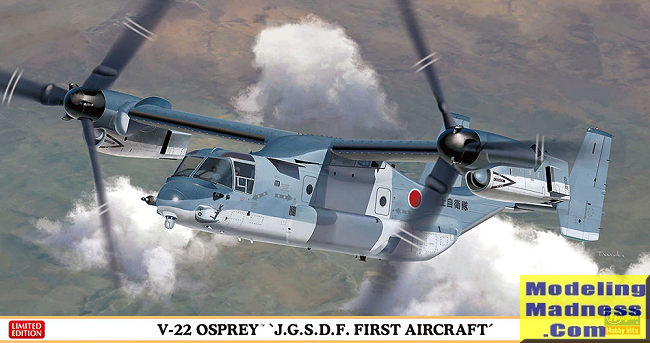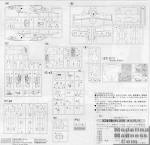
| KIT #: | 02277 |
| PRICE: | 3600 yen SRP |
| DECALS: | One option |
| REVIEWER: | Scott Van Aken |
| NOTES: | 2018 boxing |

| HISTORY |
The Bell Boeing V-22 Osprey is an American multi-mission, tiltrotor military aircraft with both a vertical takeoff and landing (VTOL), and short takeoff and landing (STOL) capability. It is designed to combine the functionality of a conventional helicopter with the long-range, high-speed cruise performance of a turboprop aircraft.
The V-22 originated from the United States Department of Defense Joint-service Vertical take-off/landing Experimental (JVX) aircraft program started in 1981. The team of Bell Helicopter and Boeing Helicopters was awarded a development contract in 1983 for the tiltrotor aircraft. The Bell Boeing team jointly produce the aircraft. The V-22 first flew in 1989, and began flight testing and design alterations; the complexity and difficulties of being the first tiltrotor intended for military service in the world led to many years of development.
The United States Marine Corps began crew training for the Osprey in 2000, and fielded it in 2007; it supplemented and then replaced their Boeing Vertol CH-46 Sea Knights. The Osprey's other operator, the U.S. Air Force, fielded their version of the tiltrotor in 2009. Since entering service with the U.S. Marine Corps and Air Force, the Osprey has been deployed in transportation and medivac operations over Iraq, Afghanistan, Libya and Kuwait.
Fourteen USMC and five USAF squadrons operate the Osprey. The Type has been slow to enter foreign service with the Japanese being one of the first export sales.
| THE KIT |
 It
used to be that as soon as a prototype of an aircraft was produced, Hasegawa
and others would rush out and mold a kit. However, having been bitten by
airframe changes between the prototype and production planes, most companies
will now wait for the definitive production aircraft before expending the
funds. Back in the very early 1990s, Italeri jumped on the Osprey by
producing kits in both 1/72 and 1/48 of the prototypes. Your editor built
the Italeri version in 1/48 and it was quite a struggle! Now, Hasegawa has
provided us with what looks to be a very nice kit of this plane in 1/72
scale, the scale in which I prefer to build (as much due to diminishing
shelf space as anything else).
It
used to be that as soon as a prototype of an aircraft was produced, Hasegawa
and others would rush out and mold a kit. However, having been bitten by
airframe changes between the prototype and production planes, most companies
will now wait for the definitive production aircraft before expending the
funds. Back in the very early 1990s, Italeri jumped on the Osprey by
producing kits in both 1/72 and 1/48 of the prototypes. Your editor built
the Italeri version in 1/48 and it was quite a struggle! Now, Hasegawa has
provided us with what looks to be a very nice kit of this plane in 1/72
scale, the scale in which I prefer to build (as much due to diminishing
shelf space as anything else). Instructions
use Gunze paint references and while the instructions look complex at first
glance, studying them shows that they are quite logically arranged and
should be quite helpful. This kit may be a bit of a rush into production
even though it is little more than a decal chance from the basic boxing. It
has two shades of grey with the upper color being shallow ocean blue.
Somewhat reminds me of the USN tricolor scheme used during WWII. So new
is this that there are no serial numbers included with the kit. The
decal sheet is very nicely done and should provide no issues. Since this kit
is identical in terms of parts to the initial boxing, one could use USMC
aftermarket decals on it.
Instructions
use Gunze paint references and while the instructions look complex at first
glance, studying them shows that they are quite logically arranged and
should be quite helpful. This kit may be a bit of a rush into production
even though it is little more than a decal chance from the basic boxing. It
has two shades of grey with the upper color being shallow ocean blue.
Somewhat reminds me of the USN tricolor scheme used during WWII. So new
is this that there are no serial numbers included with the kit. The
decal sheet is very nicely done and should provide no issues. Since this kit
is identical in terms of parts to the initial boxing, one could use USMC
aftermarket decals on it.
| CONCLUSIONS |
One expects a nice kit from Hasegawa and in this case, you do get it. Well worth picking up if you are a fan of modern aircraft. As a note, for those who don't mind waiting a bit for your kits, it could be useful to pick up from Japanese retailers as even with the shipping, it will probably be less expensive than US retail and even most discount places.
| REFERENCES |
https://en.wikipedia.org/wiki/Bell_Boeing_V-22_Osprey
August 2018
Thanks to me for picking this one up.
If you would like your product reviewed fairly and quickly, please contact the editor or see other details in the Note to Contributors.